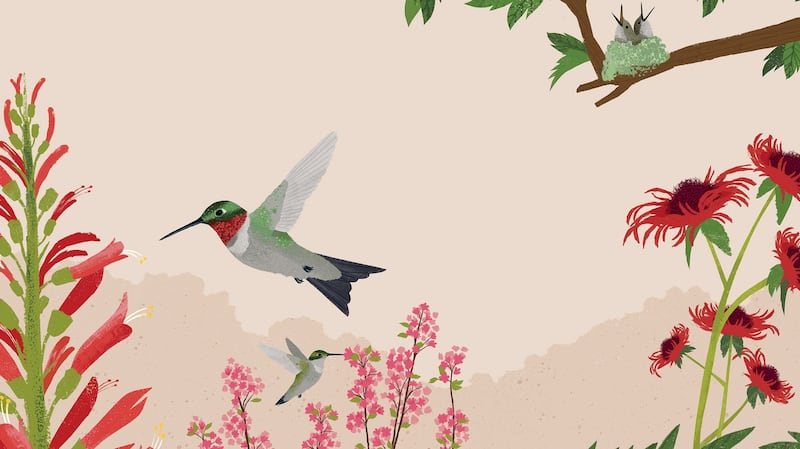As autumn turns to winter in Ireland, the stream-tailed swallows start heading south, an impulse for migration shared by hundreds of creatures from the animal kingdom. In We Travel So Far (Words and Pictures, 4+, £12.99), Laura Knowles charts 26 similar migrations, in a series of short stories that sing like poems.
Knowles allows the animals and birds - from the majestic monarch butterfly to a flock of wheeling whooping cranes - tell their own tales: “We are the night-time flappers, the sweet-treat snackers!” hum a “humongous” horde of hanging fruit bats.
Chris Madden’s stunning illustrations bring detail and perspective to the varying habitats. The foregrounded figures of a pair of elephant seals, for example, are multiplied in miniature along a beach that recedes into the distance. In the final short story, Knowles reminds us of the human impulse to move from one place to another, “to find adventure”, “to find safety”, “to find love.”

The Mediterranean by Armin Greder (Allen and Unwin, 8+, £12.99) looks at the idea of migration through the lens of the current refugee crisis. Do not be deceived by the fact that Greder takes a picture-book approach: he paints a harrowing picture of the reality of forced migration. The almost wordless story opens with a lifeless body floating in the water. In a series of rubbed charcoal drawings, full of smudged faces and oppressive landscapes, Greder brings us on a circular journey that reveals the world of war and poverty that forces millions of people every year to flee their homes. The darkness of the theme notwithstanding, The Mediterranean opens up an opportunity to have deeper conversations with a child about the current global political landscape.
Illegal, a graphic novel by Eoin Colfer and Andrew Donkin, illustrated by Giovanni Rigani (Hodder Children's Press, 9+, £14.00), also opens with a journey across the Mediterranean Sea. It charts the escape of a 12 year-old African boy, Ebo, as he leaves economic hardship in Africa for Europe, the continent of opportunity. The journey with his brother Kwame is marked from the outset by bad luck: a local proverb foretells doom for any two brothers to travel together. However, Ebo's childhood has made him resilient and he will rise to all the challenges he faces as he tries to make a new life for himself in Italy. Colfer and Donkin's story weaves back and forth between past and present, juxtaposing two distinct visual worlds: the scorched beige palette of African life and the nighttime blues of the boat scenes. The graphic novel approach complements the episodic nature of Ebo's tale, and Rigani's portraits create a real emotional affinity with the characters. The book closes with a short standalone comic strip detailing the story of real-life refugee. Rendered in black and white, it highlights the stark truth underpinning the tale.
Oliver Jeffers's latest picture-book celebrates the diversity of human life and the universe we are a part of. Here We Are: Notes for Living on Planet Earth (Harper Collins, 2+, £14.99) was written in the first two month's of his son's life, and it seeks to explain the enormity the world we live in in its most fundamental terms. In addressing the universal wonder of our existence, Jeffers reaches out to readers of all ages, in his typically wry style. However, the simplicity of the language and intimacy of the address, makes it a deeply personal book. As usual, Jeffers does not scrimp on detail in his drawings, which offer glimpses of the cosmos, bucolic countryside scenes, cityscapes, and a veritable encyclopedia of human beings and animals.
Gringer the Whinger by Jane Landy (Golden Key, 2+, €16) was also inspired by the author's children: Landy used stories of the eponymous grumbling dragon as a diversion tactic during painful dinner times when her own children were small. The rhyming story unfolds over one such meal, when moany Gringer arrives to disturb the fragile domestic peace with his unreasonable demands. Sheena Dempsey's illustrations are the real winner here, brilliantly capturing the frazzled patience of the exhausted parents. A quick glance at the mother's furrowed brow and the father's unshaven resignation will have adult readers chuckling in recognition.
Naomi Peppard provides some brilliant facial expressions for the boy in Don Briggs' story-poem The Return of the Dragon (Linden, 3+, €10), another dragon-themed picture book for very young readers. Peppard's watercolour illustrations bring to life the increasingly improbable scenarios imagined by a boy whose pet dragon goes missing. Briggs uses simple, accessible rhyme to narrate the story, which has an altruistic heart, just like the book itself: 100 per cent of the proceeds go towards Temple Street Children's Hospital.

Tales for the Telling by Edna O'Brien (Palazzo, 5+ £16.99) features no dragons, but there are plenty of other strange beasts and fantastic creatures, including giants, leprechauns, fools and fairies. Originally published in 1986, the collection of Irish folk and fairy tales has long been out of print, and its reappearance will delight adults who remember it from their own childhood. The prologue - narrated in idiom by a slurring country storyteller - betrays O'Brien's mischievous intent, and she spares young none of her wit or literary style. This is a really handsome edition too, featuring full-page renderings of Michael Foreman's original watercolour illustrations.
The Murderer's Ape (Pushkin Children's, 10+, £12.99) by Jakob Wegelius is narrated by Sally Jones, a gorilla who has no voice but plenty to say. Luckily she has access to a typewriter, given to her by her friend and master Henry Kolkas, a sea-captain who is wrongly accused of murder. Sally is a compelling narrator with an unusual perspective on the strange events unfolding around her, as she crosses continents trying to solve the mystery of who really murdered Alphonse Morro. In a market thick with variations on a similar theme, The Murderer's Ape stands out as a truly original work.


















